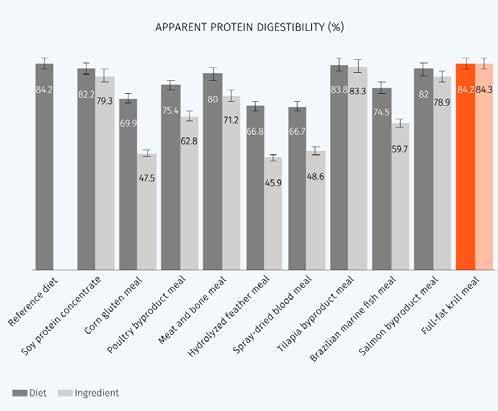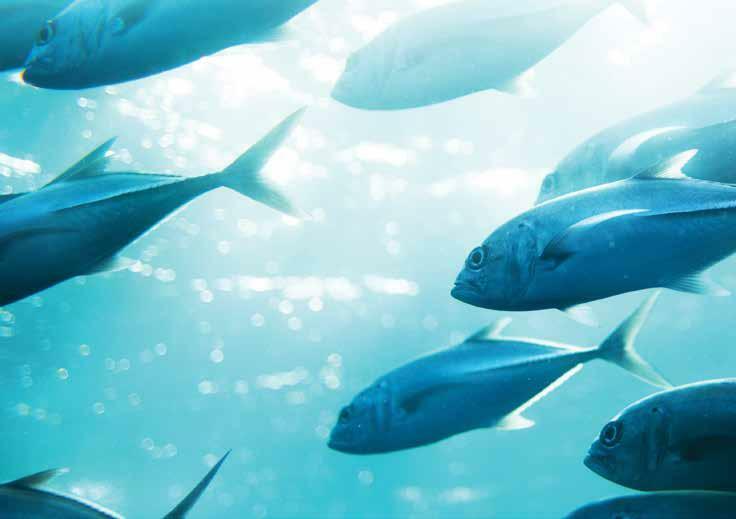
10 minute read
Krill meal proves to be an impactful source of protein in Pacific white leg shrimp diets
In a new study on digestibility of crude protein and essential amino acids, krill meal exhibited the highest apparent digestibility
By Chaiyot Rawekchom
The Pacific whiteleg shrimp Penaeus vannamei has emerged in recent decades as one of the most important farmed shrimp species worldwide, accounting 2.5 “While we did not participate in the study, on behalf of Aker BioMarine, we were pleased to supply the researchers for 82% of global shrimp production (Liao and Chien, 2011). Native to the Pacific coast of Latin America, Krill meal proves to be an impactful source of protein in Pacific whiteleg shrimp diets whiteleg shrimp was commercially introduced to the Asian market in the 1990s. Since then, its production In a new study on digestibility of crude protein and essential amino acids, krill meal exhibited across the continent has grown exponentially, with demand rising. the highest apparent crude protein digestibility One of the costliest and most critical elements in raising whiteleg shrimp is protein (Allen Davis and Miles, 2021). It is an essential part of the shrimp diet and can be the deciding factor when it comes to shrimp growth. But finding the right source and amount of protein as a dietary ingredient has become somewhat of a balancing act for farmers. Too little limits growth and too much is costly and may not be fully absorbed by the shrimp (Lee and Lee, 2018). This means that shrimp farmers must find an optimal source and amount of protein for their feeds, while taking their costs into consideration and not compromising the growth and development of the shrimp. As cost pressure increases on this industry, farmers will have to turn to ingredients that ensure the greatest possible nutritional impact on culture performance. with our QRILL Aqua product. We fully understand that independent research and academic interest in the effects of krill meal on aquaculture species are key to building a better understanding of the full potential of this Antarctic crustacean and how it can affect growth performance,” said Lena Burri, R&D Director for Animal Nutrition and Health, Aker BioMarine. Research is a key part of the Aker BioMarine strategy to build more knowledge around krill and its role in human and planetary health. Harvested in the pristine waters of the Southern Ocean, krill meal from Aker BioMarine is sustainably sourced and closely monitored by international bodies. These efforts have helped support the growth of krill biomass. Krill feeds on phytoplankton and algae, which in turn boost its nutrient-packed nature. Over the last few decades, there has been increased attention on krill as a key ingredient in animal feeds, particularly as a potential gamechanger in the aquaculture industry,” added Burri. “Krill is known to be rich in omega-3 phospholipids and now, thanks to Labomar and their scientists, more is known about krill as a source of crude protein and amino acids.”
By Chaiyot Rawekchom The Pacific whiteleg shrimp Penaeus vannamei has emerged in recent decades as one of the most important farmed shrimp species worldwide, accounting for 82% of global shrimp production (Liao and Chien, 2011). Native to the Pacific coast of Latin America, whiteleg shrimp was commercially introduced to the Asian market in the 1990s. Since then, its production across the continent has grown exponentially, with demand rising. One of the costliest and most critical elements in raising whiteleg shrimp is protein (Allen Davis and Miles, 2021). It is an essential part of the shrimp diet and can be the deciding factor when it comes to shrimp growth. But finding the right source and amount of protein as a dietary ingredient has become somewhat of a balancing act for farmers. Too little limits growth and too much is costly and may not be fully absorbed by the shrimp (Lee and Lee, 2018) Krill meal stands out as an optimal source of protein This means that shrimp farmers must find an optimal source and amount of protein for their dietary feeds, while taking their costs into consideration and not compromising the growth and The hunt for the ultimate source of protein for shrimp diets The quest for the ultimate source of protein for shrimp Krill meal has been identified as an optimal source of protein and proven to improve feed efficiency and growth performance, which have direct economic effects on the development of the shrimp. As cost pressure increases on this industry, farmers will have to turn to ingredients that ensure the greatest possible nutritional impact on culture performance. diets is what led the Labomar scientists to embark on their new study, published in 2022. The research, “Apparent digestibility of protein and essential amino shrimp farms. Because of its growing reputation as an impactful ingredient in aquafeeds, krill meal (under the Krill meal stands out as an optimal source of protein acids from commonly used feed ingredients in Brazil for juvenile shrimp Litopenaeus vannamei”, aimed to uncover QRILL Aqua brand provided by Aker BioMarine) recently came under the lens of the marine scientists at Labomar, Krill meal has been identified as an optimal source of protein and proven to improve feed the digestibility of crude protein and essential amino acids in various types of ingredients, including krill meal, the Marine Sciences Institute in Northeast Brazil. efficiency and growth performance, which have direct economic effects on the shrimp farms. for Pacific whiteleg shrimp diets. The major drawback, Because of its growing reputation as an impactful ingredient in aquafeeds, krill meal (under the according to the Labomar team, is the lower availability of important nutrients and poorer attractability of these QRILL Aqua brand provided by Aker BioMarine) recently came under the lens of the marine ingredients, making these protein sources less likely to scientists at Labomar, the Marine Sciences Institute in Northeast Brazil. attract the shrimp to consume the feed, as well as lower digestibility. “Shrimp farmers today are feeling the cost pressure, and they are in need of more reliable sources of protein in their feeds,” said Burri. “One of the ways to ensure reliability of the ingredients is to evaluate whether the shrimp are getting the full benefits of that ingredient. This requires a deeper investigation into whether the ingredient exhibits high digestibility, meaning more nutrients being absorbed and used in the body, as well as high attractability, meaning the shrimp are enticed by the ingredient and consume more of it.”
Figure 1. Apparent crude protein digestibility (ACPD) of test diets and ingredients for juvenile Litopenaeus vannamei.

The scientific team at Labomar started with the premise that farmers are increasingly turning to lower cost terrestrial plant protein products, such as soybean, Figure 1. Apparent crude protein digestibility (ACPD) of test diets and ingredients for juvenile canola, corn and wheat, as well as animal meals. Litopenaeus vannamei.
Three-phase juvenile shrimp trial run in Finding 2: Krill meal was a top performing ingredient
Brazil evaluates various protein sources Krill meal exhibited the highest apparent crude protein digestibility (84.3%) and apparent The Labomar study, conducted in the State of Ceará, essential amino acid digestibility (86.5%) among all test ingredients. The shrimp consuming the NE Brazil, set out to evaluate the effects of a variety of krill meal diet also showed the best growth performance, the highest weekly growth, and the conventional protein sources among juvenile Pacific whiteleg shrimp test subjects. lowest feed conversion ratio.
The team measured the growth performance, attractability and digestibility of the protein sources, over the course of The crude protein and essential amino acid content in commercially available feed ingredients three distinct phases, each lasting 29-30 days. The first for whiteleg shrimp should not be taken as the sole indicator of their quality. Instead, apparent phase included rearing the shrimp. During the second phase, the scientists compared the effects of individual ingredients in a two-by-two comparison. In the final phase, digestibility coefficients should be documented along with other parameters to judge quality and better predict shrimp culture performance. the apparent digestibility for crude protein and essential Aquatic ingredients are the most effective shrimp feed additives amino acids of selected ingredients was determined. Shrimp survival exceeded 96% at close of study and was unaffected by the test ingredients. “Protein digestibility is an important factor that defines the quality and value of commercial raw materials. It allows formulating on a digestible protein and amino acid basis, while improving feed efficiency and shrimp growth performance,” said the authors in their published findings. (https://www.rbz.org.br/wp-content/uploads/articles_ xml/1806-9290-rbz-51-e20210177/1806-9290-rbz51-e20210177.pdf) The protein ingredients under evaluation during this trial included soy protein concentrate, corn gluten meal, poultry by product meal, meat and bone meal, hydrolysed feather meal, spray-dried blood meal, tilapia byproduct meal, Brazilian marine fish meal, salmon by product meal and krill meal from Aker BioMarine. Each test group was fed a specific diet to measure the distinct effects of each of the key protein and amino acid ingredients. Following the experiment, the Labomar team made some key discoveries which demonstrate that not all protein sources are equally effective as a dietary ingredient. Here are three key findings from the study:
Finding 1: Aquatic ingredients yield high crude protein and essential amino acid digestibility
The apparent digestibility for crude protein for most aquatic proteins was high compared to plant and terrestrial animal byproducts. The salmon by product meal, soy protein concentrate, tilapia by product meal, and full-fat krill meal are preferable ingredients in feeds for the whiteleg shrimp since they carry a high crude protein and essential amino acid content (>600g/kg) combined with apparent digestibility coefficients near or in excess of 80%.
Krill meal exhibited the highest apparent crude protein digestibility (84.3%) and apparent essential amino acid digestibility (86.5%) among all test ingredients. The shrimp consuming the krill meal diet also showed the best growth performance, the highest weekly growth, and the lowest feed conversion ratio.
The crude protein and essential amino acid content in commercially available feed ingredients for whiteleg shrimp should not be taken as the sole indicator of their quality. Instead, apparent digestibility coefficients should be documented along with other parameters to judge quality and better predict shrimp culture performance.
Overall, the Labomar research team concluded that the aquatic ingredients, in general, yielded higher crude protein and essential amino acid digestibility, making them
the more effective additives to shrimp feeds. Krill meal was a standout performer among the test groups, giving the best results in comparison to all other ingredients in the experiment.
In addition, Dr Alberto J.P. Nunes from Instituto de Ciências do Mar (Labomar) pointed out some key findings related to how farmers should evaluate their raw materials:
“This study shows that protein and amino acid digestibility of raw materials has a greater importance than their crude values and should be carefully considered during ingredient selection and feed formulation,” said Nunes, upon the announcement of the study results.
“We see that aquatic protein sources and krill meal specifically have proven to increase feed efficiency and growth performance of juvenile shrimp, which will likely have direct implications on water quality and economic performance of shrimp farms,” he added.
The complete article detailing the Labomar study is now available on Revista Brasileira de Zootecnia. (https:// www.rbz.org.br/article/apparent-digestibility-of-proteinand-essential-aminoacids-from-commonly-used-feedingredients-in-brazil-for-juvenile-shrimp-litopenaeusvannamei/). The experimental trial was part of the Master of Science thesis for Carolina Vieira, and was supervised by Dr Alberto J.P. Nunes, and co-authored by Drs Ricardo Pinto and Alexandre Diógenes.

References
Allen Davis, D., Miles, R.D., 2001. Maximize feed efficiency through proper protein management. (globalseafood.org https:// www.globalseafood.org/advocate/maximize-feed-efficiencythrough-proper-protein-management/) Lee, C., Lee, K.J., 2018. Dietary protein requirement of Pacific white shrimp Litopenaeus vannamei in three different growth stages. Fish Aquatic Sci 21, 30 (2018). https://doi.org/10.1186/ s41240-018-0105-0 ( Full Text at https://fas.biomedcentral.com/ articles/10.1186/s41240-018-0105-0) Liao, I-C., Chien, Y-H., 2011. The Pacific White Shrimp, Litopenaeus vannamei, in Asia: The World’s Most Widely Cultured Alien Crustacean. 10.1007/978-94-007-0591-3_17.
Chaiyot Rawekchom is Regional Sales Director Qrill SEA, Aker BioMarine – Thailand. Email:Chaiyot.Rawekchom@akerbiomarine.com
The Future Awaits
Built on partnership and innovation, Wenger is providing more opportunities for client success.

For almost a century, Wenger has delivered extrusion-based innovations to our partners. We’ve worked alongside you to develop new processing solutions and better products, providing our industry-leading expertise and ongoing support every step of the way. We don’t plan on stopping any time soon. Wenger’s global food processing family is growing, and we look forward to the exciting opportunities that lie ahead. We will continue to deliver even more innovations and technologies to benefit companies that share our vision of tomorrow.
Wenger.com










